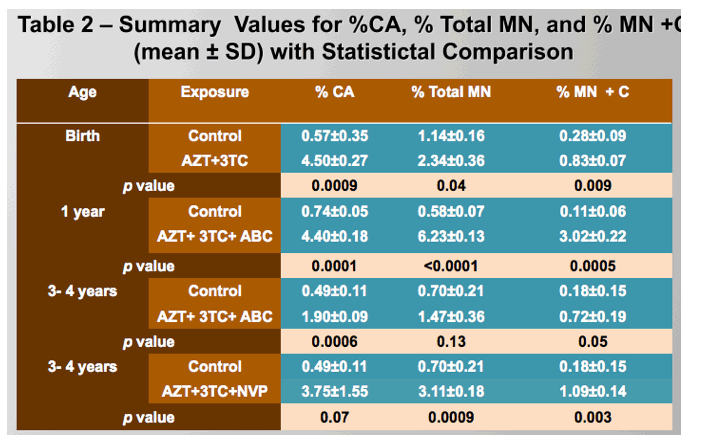 |
 |
 |
| |
Exposure to nucleoside reverse transcriptase inhibitors (NRTIs) induces genotoxicity persistent for up to three years in Erythrocebus patas monkeys
|
| |
| |
Reported by Jules Levin
19th IAC Wash Dc 2012 July 22-27
L. Rivera Torres1, M.C. Poirier1, S. Gorjifard1, Y. Liu1, R.A. Woodward2, O.A. Olivero1
1National Cancer Institute (NCI), Laboratory of Cancer Biology and Genetics, Carcinogen-DNA Interaction Section, Bethesda, United States, 2National Institutes of Health, Animal Center, Poolesville, United States
"data provide a novel mechanism for cancer induction by the NRTIs.....NRTIs are given during pregnancy and after birth to reduce maternal-fetal HIV-1 transmission.....These drugs are DNA replication chain terminators, and induce: centrosomal amplification (CA, >2 centrosomes/nucleus), resulting in abnormal chromosomal segregation; as well as micronuclei (MN), and MN with whole chromosomes (MN+C)......genotoxicity, including abnormal chromosomal segregation and aneuploidy, initiated by in utero NRTI exposure, persists in patas bone marrow up to 3 years of age"
wikipedia: Aneuploidy is an abnormal number of chromosomes, and is a type of chromosome abnormality. An extra or missing chromosome is a common cause of genetic disorders (birth defects). Some cancer cells also have abnormal numbers of chromosomes.[1] Aneuploidy occurs during cell division when the chromosomes do not separate properly between the two cells. Chromosome abnormalities occur in 1 of 160 live births.This generally happens when cytokinesis starts occurring while karyokinesis is still under the process. Most cases of aneuploidy result in termination of the developing fetus, but there can be cases of live birth; the most common extra chromosomes among live births are 21, 18 and 13.[2]
Different species have different numbers of normal chromosomes and thus the term "aneuploidy" refers to the chromosome number being different for that species.
ABSTRACT
· Antiretroviral NRTIs are given during pregnancy and after birth to reduce maternal-fetal HIV-1 transmission.
· These drugs are DNA replication chain terminators, and induce: centrosomal amplification (CA, >2 centrosomes/nucleus), resulting in abnormal chromosomal segregation; as well as micronuclei (MN), and MN with whole chromosomes (MN+C).
· Pregnant Erythrocebus patas (patas) monkey dams (n=2-3/group) were given human-equivalent daily doses of the NRTIs Zidovudine (AZT) and Lamivudine (3TC), for the last half (10 wk) of gestation.
· At birth unexposed and AZT/3TC-exposed fetuses had CA [and] was found in 0.57 ± 0.4% and 4.50 ± 0.3% of cells from, respectively (p = 0.0009). There were 1.14 ± 0.2% and 2.34 ± 0.4% of cells with MN in unexposed fetuses and AZT/3TC-exposed fetuses, respectively (p = 0.04). MN+C were found in 0.28 ± 0.1% and 0.83 ± 0.1% of cells from unexposed and AZT/3TC-exposed fetuses, respectively (p = 0.009).
· At 1 year of age, patas exposed to AZT/3TC/ABC exhibit 4.4 ± 0.2% of cells with CA and the controls had 0.74 ± 0.1% (p = 0.0001). MN values in control animals were of 0.58 ± 0.1% and of 6.23 ± 0.1% in exposed animals (p= 0.0001). MN+C were 0.11 ± 0.1% in control animals and 3.02 ± 0.2% in exposed animals.
·For the patas taken at 3 years of age, CA was found in 0.49 ± 0.1% and 1.90% (p = 0.0006)of cells from unexposed and AZT/3TC/ABC exposed patas, respectively. Unexposed and AZT/3TC/ABC exposed fetuses had 0.70 ± 0.2% and 1.47± 0.4% of cells with MN, respectively (p= 0.13). For MN+C, unexposed and AZT/3TC/ABC-exposed fetuses had 0.18 ± 0.2% and 1.72 ± 0.2% of cells affected, respectively (p=0.05). An additional group of animals was exposed to AZT/3TC/NVP and exhibited 3.75 ± 1.6% CA, 3.11 ± 0.2% MN and 1.09 ± 0.1% MN+C, with p values of 0.07, 0.0009 and 0.003 respectively.
· Therefore, genotoxicity, including abnormal chromosomal segregation and aneuploidy, initiated by in utero NRTI exposure, persists in patas bone marrow up to 3 years of age.







|
| |
|
 |
 |
|
|